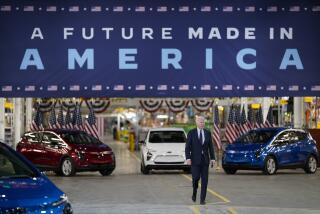U.S. to limit greenhouse gas emissions from autos
WASHINGTON â The agreement that the Obama administration will announce today forcing dramatic reductions in vehicle greenhouse gas emissions and improvements in auto mileage marks a potentially pivotal shift in the battle over global warming -- and a vindication of Californiaâs long battle to toughen standards.
After decades of political sparring, legal challenges and scientific arguments over climate change, three of the central players -- the federal government, major U.S. automakers and California -- have found that the time has come to suspend hostilities and make a deal.
For cars and trucks, the agreement would establish a single nationwide standard that would require a 30% reduction in carbon dioxide and other emissions from vehicles sold in the United States by 2016.
The new limits are projected to reduce U.S. oil consumption by about 5% a year. The nation currently uses about 7.1 billion barrels a year.
For its part, California will essentially accept the national standard as a substitute for the stateâs own tough emission requirements. The Obama standard is designed to achieve the same level of emission cutbacks as the California rule, but automakers will be given more time to adapt.
Completing the three-way deal, automakers will pledge to drop their effort to block the California rules through legal challenges.
âEverybody wins,â said David Doniger, policy director of the Natural Resources Defense Councilâs climate center. âItâs going to cut carbon pollution. The drivers of these cars are going to save money at the pump. Itâs going to cut our national oil dependence.â
During the Bush administration, California unsuccessfully sought federal permission to tighten its vehicle emission standards. The Obama administration had ordered the Environmental Protection Agency to reexamine the issue.
Not everyone hailed the agreement Monday. âWe think these new mandatory fuel standards are most unfortunate,â said Myron Ebell, an energy expert with the pro-market Competitive Enterprise Institute. âThey will price people out of larger vehicles and force them into smaller vehicles.â
But in embracing a deal, the major parties appear to have concluded that some kind of action on greenhouses gases was inevitable and that their separate interests were better served by compromising now than by further delay. President Obama will announce the deal in Washington, joined by California Gov. Arnold Schwarzenegger and others.
A White House official, briefing reporters Monday on condition of anonymity, said the agreement would push new vehicles sold in the U.S. to average 35.5 miles per gallon in 2016, up from 25 mpg today. The agreement, coupled with increased fuel-efficiency requirements that Congress approved in 2007, would add $1,300 to the price of a new car in 2016, the administration estimated.
Neither the Obama plan nor the rules California has sought to impose include explicit mileage requirements. But capping the greenhouse gas emissions that scientists blame for global warming would effectively require better mileage.
In 2002, California passed a law to reduce vehicle emissions, but auto industry lawsuits held up its enforcement. The state also needed a waiver from the EPA, which refused -- even after a series of court rulings in the stateâs favor.
Bush administration officials said they wanted a single nationwide standard that would unite the greenhouse gas regulations and tougher fuel economy standards that Congress approved in 2007.
Officials cast such standards as a key to encouraging the design and sale of the fuel-sipping cars that Obama calls vital to the Detroit automakersâ recovery -- and crucial to the international fight against global warming.
Detroit has never liked the idea of government telling it what kind of cars to build, but its power to head off tougher emission standards was undercut by a series of events that decreased its political influence -- including the financial troubles of General Motors Corp. and Chrysler, which made the companies more open to government demands for fuel-efficient vehicles, especially after they needed federal money to stay afloat.
In addition, Rep. John D. Dingell (D-Mich.), a powerful ally of the auto industry, was ousted as chairman of the House Energy and Commerce Committee and replaced by Rep. Henry A. Waxman (D-Beverly Hills), an advocate of tougher standards. And during last yearâs presidential campaign, both Obama and Republican nominee Sen. John McCain of Arizona backed Californiaâs efforts.
Obamaâs EPA also issued a draft ruling last month declaring greenhouse gases a danger to public health, subject to regulation under the Clean Air Act. The proposal singles out cars and trucks, which comprise about one quarter of U.S. greenhouse gas emissions.
The EPA began public hearings on the proposal Monday.
Assuming the reductions come to pass, a trip to a dealership in 2016 might prove remarkably different than one today. Rows of SUVs and full-sized luxury cars could be replaced by highly efficient compact sedans powered by hybrid drive trains, small SUVs running on clean diesel motors and possibly electric cars that emit no greenhouse gases.
Jeff Holmstead, a senior EPA official under President Bush, said he saw the deal as a vindication of the Bush administrationâs approach.
âIt looks like the Obama administration is agreeing with the Bush administration that there needs to be a national standard and that it doesnât make any sense to have multiple state standards,â Holmstead said.
But Capitol Hill Democrats welcomed the deal. Rep. Edward J. Markey (D-Mass.), an author of the House energy bill who also co-wrote the 2007 bill increasing fuel economy standards, said, âPresident Obama has solved the energy and economic policy equivalent of a Rubikâs Cube.â
--
Times staff writers Ken Bensinger and Margot Roosevelt in Los Angeles contributed to this report.
--
BEGIN TEXT OF INFOBOX
The basics
The Obama administration is set to announce an agreement today that would force cars and trucks in the U.S. to achieve dramatically better gas mileage. Here is a look at the plan:
What would the new rules do exactly?
They would restrict greenhouse gas emissions from cars and trucks -- essentially forcing them to get better fuel economy. By 2016, vehicles sold in the U.S. would average 35.5 miles per gallon, up from 25 mpg today. The White House estimates that the new regulations would save nearly 2 billion barrels of oil from 2011 to 2016 and, in global warming terms, be the equivalent of taking 177 million cars off the road.
Do I have to trade in my Yukon SUV for a Prius hybrid?
No. The regulations would apply only to new cars. You donât have to scrap your gas guzzler and you wonât need to retrofit it.
Would this change my car-buying choices?
Yes. For one, the Obama administration projects you would pay an extra $1,300 per vehicle, on average, in 2016 because of the new rules. Itâs also likely that U.S. dealerships will stock more lighter vehicles with less trunk space, and possibly more advanced-fuel vehicles such as plug-in hybrids.
The federal government right now has such a heavy hand in running two big U.S. automakers, General Motors Corp. and Chrysler, because of their need for federal aid. Is that why the auto companies agreed to this?
Itâs one of several factors that pressured automakers to compromise on a single national fuel standard. Other factors include Californiaâs push to set aggressive vehicle emissions standards and the Environmental Protection Agencyâs decision, spurred by a Supreme Court ruling, to propose regulating greenhouse gases under the Clean Air Act.
Source: Los Angeles Times







